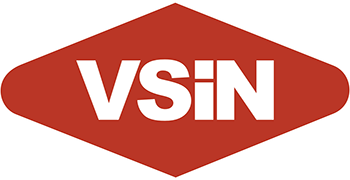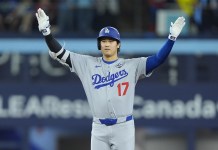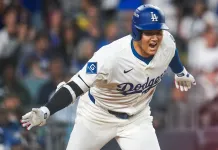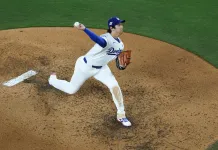Dodgers vs. Brewers
The Brewers won the battle of the bullpens in Game 5 against the Cubs and now the NLCS is set, as we’ve got the Brewers vs. Dodgers series set to begin on Monday. Milwaukee is the home team, as LA knocked off a Philadelphia team coming off of a bye. The Brewers actually had the best record in the Senior Circuit and home-field advantage seemed to come in very handy as the hosts won every game in the series.
Even though the Brewers had the league’s best record, the task at hand is far more difficult in this series against the Dodgers. According to Cot’s Contracts, the Brewers’ projected end-of-season 40-man roster cost $115 million. The Dodgers? $346.9 million. The financial imbalance of baseball is only lessened by the inherent variance of the sport. In other words, anything could happen, but money can always buy a more talented team. It’s a matter of that talent executing.
Milwaukee finished four games better than LA, as both teams won their respective divisions. In the six head-to-head regular season meetings, the Brewers won all six of them, holding the Dodgers to just 16 runs. Those series were played July 7-9 and July 18-20. Four of the games were one-run decisions.
Both teams excelled at home with 52-29 records, but the four-game gap was due to Milwaukee’s road performance and, frankly, what they did head-to-head against the Dodgers. But, now it’s the playoffs and what happened in July doesn’t really have any bearing on this series.
Let’s break down the three main phases of the game – offense, pitching, defense – and see if there’s an edge to be had.
Dodgers vs. Brewers NLCS Odds
Los Angeles Dodgers -200 // Milwaukee Brewers +170
Over/Under 4.5 Games (-700/+550) // Over/Under 5.5 Games (-160/+130) // Over/Under 6.5 Games (+215/-260)
Odds as of 8 a.m. PT from DraftKings Sportsbook on Sunday, October 12
Dodgers vs. Brewers NLCS Preview
Obviously the offensive advantages didn’t help the Dodgers in those regular season meetings, but they are pretty significant. LA hit 244 home runs compared to just 166 for Milwaukee, though I should point out that the Brewers hit seven homers in the series against the Cubs, even with two games played in good pitching weather at Wrigley Field. The Dodgers have hit seven homers in their six playoff games, with four of them at home, where they led the league with 142 dingers.
Collectively, the Dodgers batted .253/.327/.441, while the Brewers hit .258/.332/.403. Milwaukee walked less and also struck out less. The Brewers were far more engaged on the basepaths, as they had nearly double the stolen bases that the Dodgers had. Of course, when you hit for power like the Dodgers do, you don’t want to take the chance of losing baserunners. When you are a contact-oriented lineup looking to manufacture runs like the Brewers, you take a bit of a different approach.
Per FanGraphs’ all-encompassing BsR metric for baserunning, the Brewers were the best in baseball 90 feet at a time. The Cubs were third and the Dodgers were 18th, so this is a big potential advantage for Milwaukee in this series and one that they didn’t have last series. Milwaukee was also at a power disadvantage against Chicago and got out-homered 9-7, but won the series regardless.
This is a command-based pitching staff for the Brewers, designed to use a terrific defense to get outs rather than go for swings and misses all the time. Most of the guys aren’t overpowering, but a lot of them are simply looking to mix pitches, change speeds, and avoid the Barrel. More on that in a bit, but they’ll have to do precisely that to have success in this series. The Dodgers ranked seventh in the regular season in Hard Hit%, but were one of just five teams with a double-digit Barrel% at exactly 10%. The Brewers, meanwhile, ranked 25th in Hard Hit% and 29th in Barrel%.
While the Dodgers had one of the best home offenses in baseball, they were just 11th in wOBA on the road at .315, posting a .245/.317/.409 slash. Milwaukee was actually a top-five road offense, thriving away from American Family Field, which is typically going to play better as a pitcher’s park. That said, it is worth noting that the Dodgers do play at Petco Park and Oracle Park more frequently than most, so they do run into some of the better pitcher’s parks in road settings.
The Brewers only struck out 34 times in the five games against the Cubs. The Dodgers have 56 strikeouts over their six games, but that’ll happen with the Phillies pitching staff. I do think that a lot of contact gets made in this series, so hitting with RISP will be very important. The Dodgers were the best in baseball at that by wOBA, while the Brewers were seventh.
All in all, the Dodgers have the advantage here. Milwaukee stymied them in July over those six games, but on the whole, LA’s better contact authority and power numbers make the difference here, even if the Brewers do a lot of things well themselves.
Advantage: Dodgers
Pitching
When these two teams played in the regular season, Milwaukee chased Yoshinobu Yamamoto out of his start in the first innings. They also faced Clayton Kershaw twice and Tyler Glasnow twice. Emmet Sheehan had the other start. So, they did not face Blake Snell or Shohei Ohtani, who they will face in this series. And they’ll see Yamamoto again.
Milwaukee will MacGyver together a pitching staff here. Freddy Peralta pitched Game 4 against the Cubs, so he won’t be ready to go until Game 2, while the Dodgers, who finished off the Phillies in four games, will be able to set up their pitching staff pretty much exactly how they want it.
Jacob Misiorowski will factor into the equation at some point for Milwaukee, but he did go four full days between appearances in the NLDS, throwing 57 pitches on Oct. 6 and 54 pitches on Oct. 11. The Brewers have millions of reasons to be protective of their top pitching prospect, so I don’t know when we might see him in this series. The earliest based on that would be Game 3.
Quinn Priester, who didn’t last an inning in Game 3 on Oct. 8, seems the most likely option for Game 1, probably preceded by a left-handed opener in an effort to get through Ohtani, Freedie Freeman, and Max Muncy. Jose Quintana could be involved in a piggyback at some point in the series too.
The Dodgers have fewer decisions to make, as it seems like it will be Snell, Ohtani, Yamamoto, and Glasnow for the first four games. They also only needed three relievers on Thursday in the Game 4 series clincher, so their bullpen is in fantastic shape. That’s especially true when you consider that they’ve been using Roki Sasaki as a high-leverage relief option and he threw 36 pitches on Thursday. Like Misiorowski, the Dodgers will use him in a key spot, but they’re also not going to overwork him with an eye towards the future.
Statistically, the Brewers were second in team ERA at 3.59, while the Dodgers were 16th at 3.95. But, if we look at the final two months of the season when the Dodgers were able to use Ohtani and Snell, they were second in ERA at 3.35. The Dodgers got a lot healthier as the season rolled along and that made a big difference. I’ve talked about this in both series previews, but the only guys to throw over 100 innings for the Dodgers were Yamamoto, Kershaw, and Dustin May, who isn’t even in the organization anymore.
Over their final 53 games, the Dodgers had a league-leading 28.4% K%. The Brewers were fifth at 24.7%, with a lot of that coming from their relief arms. Brandon Woodruff was also really good, but he seems like a long shot to pitch in this series after suffering a strained lat in mid-September.
These are two really solid pitching staffs. Obviously the Dodgers have more name value, and I don’t think a lot of people realize how good the Brewers have been with a lot of relative unknowns, but they’ve been solid.
Still, the landscape for the Dodgers is so much different having Snell and Ohtani and that tips the scales in their favor in my mind.
Advantage: Dodgers
Defense
The Brewers are a good baseball team. I’m sure that sounds obvious given that they had the best record in the NL, but what I mean is that they are fundamentally sound. They run the bases well. They put a lot of balls in play. And they play some spectacular defense.
Milwaukee finished the regular season fifth in Outs Above Average at +29. The Dodgers were 11th at +11. LA was +17 in OAA around the infield, while Milwaukee was +12, but there is a 23-run gap in terms of outfield defense. Milwaukee finished +17, third in the league, while the Dodgers finished 19th at -6. So, this could be a clear area of strength for Milwaukee.
William Contreras and the Dodger backstops were similar in Catcher’s Caught Stealing Above Average, but Will Smith is one of the worst framers in baseball. Contreras is certainly better in that department.
Advantage: Brewers
Dodgers vs. Brewers NLCS Prediction
The Dodgers deserve to be favored in this series. The -200 price might be a tad steep, but it still only implies a 66.67% probability that they advance. I think if you surveyed some influential bettors and bookmakers, they’d probably say that the Dodgers win this series at least two out of every three times.
I’ve already got a Dodgers World Series ticket at 5/1 from before the playoffs, so I’m not going to double down on it here. I do think that they have the Game 1 advantage, much like Toronto does in their series, so that also dictates my thinking on the series, given that the Dodgers will be at a much higher price if they do win Game 1 and take away home-field advantage.
But, pre-series, I don’t really have anything here. I do expect LA to win. I could see a case where Dodgers -1.5 Games at -105 is attractive to bettors. After all, they look like they’ve woken up after some doldrums during the regular season.
Prediction: Dodgers win series; consider Dodgers -1.5 Games (-105)






